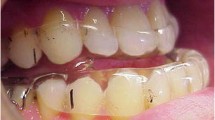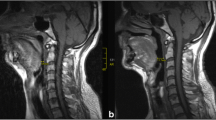Abstract
The objectives were to evaluate the impact of body posture on cephalometric measures and the level and the extent to which treatment with a mandibular protruding device (MPD) affects pharyngeal width. The study was composed of 77 patients: 50 were diagnosed with obstructive sleep apnea (OSA) and 27 snored. After each patient underwent a baseline medical (including a somnographic registration), dental and stomatognathic examination, an MPD that would protrude the mandible 75% of the maximal protrusion range was fabricated. In a radiographic examination, four cephalograms were taken: two in the upright position with and without the MPD and two in the supine position with and without the MPD. The cephalometric measures focused on the pharyngeal structures. MPD treatment significantly increased the relative pharyngeal area (at the level of the oropharynx and the hypopharynx) by a mean of +89.6 mm2 (P < 0.01) in the upright posture. The relative pharyngeal area, however, was reduced by more than 50% in the supine position compared with the upright position, independent of MPD treatment. In the supine position, compared with upright, most pharyngeal measures decreased significantly; the hyoid was significantly lower and displaced posteriorly, and the area of the velum increased by a mean of +201.2 mm2 (P < 0.001). We conclude that the MPD significantly increased most pharyngeal measures except the linear distance between the hyoid bone and the third vertebra and decreased the area of the velum.
Similar content being viewed by others
References
Miyamoto K, Ozbek MM, Lowe AA, Fleetham JA. Effect of body position on tongue posture in awake patients with obstructive sleep apnoea. Thorax 1997;52:255–259
Solow B, Skov S, Ovesen J, Norup PW, Wildschiödtz G. Airway dimensions and head posture in obstructive sleep apnoea. Eur J Orthod 1996;18:571–579
Lowe AA, Ono T, Ferguson KA, Pae E-K, Ryan FR, Fleetham JA. Cephalometric comparisons of craniofacial and upper airway structure by skeletal subtype and gender in patients with obstructive sleep apnea. Am J Orthod Dentofac Orthop 1996;110:653–664
Battagel J, Johal A, Kotecha B. A cephalometric comparison of subjects with snoring and obstructive sleep apnoea. Eur J Orthod 2000;22:353–365
Bonham PE, Currier GF, Orr WC, Othman J, Nanda RS. The effect of a modified functional appliance on obstructive sleep apnea. Am J Orthod Dentofac Orthop 1988;94:384–392
Yildirim N, Fitzpatrick MF, Whyte KF, Jalleh R, Wightman AJA, Douglas NJ. The effect of posture on upper airway dimensions in normal subjects and in patients with the sleep apnea/hypopnea syndrome. Am Rev Respir Dis 1991;144:845–847
Battagel JM, Johal A, L’Estrange PR, Croft CB, Kotecha B. Changes in airway and hyoid position in response to mandibular protrusion in subjects with obstructive sleep apnoea (OSA). Eur J Orthod 1999;21:363–376
Lowe AA, özbek MM, Miyamoto K, Pae E-K, Fleetham JA. Cephalometric and demographic characteristics of obstructive sleep apnea: an evaluation with partial least squares analysis. Angle Orthod 1997;67:143–154
Pae E-K, Lowe AA, Sasaki K, Price C, Tsuchiya M, Fleetham JA. A cephalometric and electromyographic study of upper airway structures in the upright and supine positions. Am J Orthod Dentofac Orthop 1994;106:52–59
Masumi S-I, Nishigawa K, Williams AJ, Yan-Go FL, Clark GT. Effect of jaw position and posture on forced inspiratory airflow in normal subjects and patients with obstructive sleep apnea. Chest 1996;109:1484–1489
Fouke JM, Strohl KP. Effect of position and lung volume on upper airway geometry. J Appl Physiol 1987;63:375–380
Miyamoto K, özbek MM, Lowe A A et al. Mandibular posture during sleep in healthy adults. Arch Oral Biol 1998;43:269–275
Pae E-K, Lowe AA, Fleetham JA. A role of pharyngeal length in obstructive sleep apnea patients. Am J Orthod Dentofac Orthop 1997;111:12–17
Bernhold M, Bondemark L. A magnetic appliance for treatment of snoring patients with and without obstructive sleep apnea. Am J Orthod Dentofac Orthop 1998;113:144–155
Pracharktam N, Hans MG, Strohl KP, Redline S. Upright and supine cephalometric evaluation of obstructive sleep apnea syndrome and snoring subjects. Angle Orthod 1994;64:63–74
Tangugsorn V, Krogstad O, Espeland L, Lyberg T. Obstructive sleep apnea (OSA): a cephalometric analysis of severe and non-severe OSA patients. Part I: multiple comparison of cephalometric variables. Int J Adult Orthod Orthognath Surg 2000;15:139–152
Fransson AMC, Isacsson G, Leissner LC, Näsman AB, Alton MK. Treatment of snoring and obstructive sleep apnea with a mandibular protruding device: an open-label study. Sleep Breath 2001;5:23–34
George PT. Treatment of snoring and obstructive sleep apnea with a dental device. Dent Update 1996;23:12–19
Iikubo M, Korsell S, Omnell K-Å. Description of a new cephalostat and its performance. Dentomaxillofac Radiol 1975;4:25–29
Athanasiou AE, Papadopoulos MA, Mazaheri M, Lagoudakis M. Cephalometric evaluation of pharynx, soft palate, adenoid tissue, tongue, and hyoid bone following the use of a mandibular repositioning appliance in obstructive sleep apnea patients. Int J Adult Orthod Orthognath Surg 1994;9:273–283
Dahlberg G. Statistical Methods for Medical and Biological Students London: George Allen&Unwin LTD 1948
Montgomery D. Design and Analysis of Experiments, 4th ed. New York: Wiley; 1996
Lowe AA. Can we predict the success of dental appliance therapy for the treatment of obstructive sleep apnea based on anatomic considerations?. Sleep 1993;16:S93–95
Liu Y, Park Y-C, Lowe AA, Fleetham JA. Supine cephalometric analyses of an adjustable oral appliance used in the treatment of obstructive sleep apnea. Sleep Breath 2000;4:59–66
Gale DJ, Sawyer RH, Woodcock A, Stone P, Thompson R, O’Brien K. Do oral appliances enlarge the airway in patients with obstructive sleep apnoea?. A prospective computerized tomographic study. Eur J Orthod 2000;22:159–168
Schwartz AR, Eisele DW, Smith PL. Pharyngeal airway obstruction in obstructive sleep apnea: pathophysiology and clinical implications. Otolaryngol Clin North Am 1998;31:911–918
Ono T, Lowe AA, Ferguson KA, Pae E-K, Fleetham JA. The effect of the tongue retaining device on awake genioglossus muscle activity in patients with obstructive sleep apnea. Am J Orthod Dentofac Orthop 1996;110:28–35
L’Estrange PR, Battagel JM, Harkness B, Spratley MH, Nolan PJ, Jorgensen GI. A method of studying adaptive changes of the oropharynx to variation in mandibular position in patients with obstructive sleep apnoea. J Oral Rehabil 1996;23:699–711
Author information
Authors and Affiliations
Corresponding author
Rights and permissions
About this article
Cite this article
Fransson, A.M.C., Svenson, B.A.H. & Isacsson, G. The Effect of Posture and a Mandibular Protruding Device on Pharyngeal Dimensions: A Cephalometric Study. Sleep Breath 6, 55–68 (2002). https://doi.org/10.1007/s11325-002-0055-7
Issue Date:
DOI: https://doi.org/10.1007/s11325-002-0055-7




